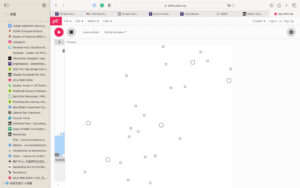Author: Wan Xinyang
week 2 post
http://<iframe src=”https://editor.p5js.org/xw2399/full/ALOjEcYW-I”></iframe>
I’ve chosen to simulate the flight pattern of a bird. Birds exhibit complex and graceful flight behaviors in nature, and I want to create a simplified simulation that captures some of these characteristics. I’ll focus on controlling the bird’s motion solely by manipulating acceleration, mimicking the bird’s ability to adjust its flight path. In this code, I’ve calculated the acceleration of birds.
week 3 post
http://<iframe src=”https://editor.p5js.org/xw2399/full/IYbVDjIoY”></iframe>
Concept: I create a visual pattern where multiple objects (movers) move around invisible attractors. These attractors will exert forces on the movers, and I also incorporate additional forces to add turbulence and repulsion, creating an interesting and dynamic design.
References and Inspiration: I’ll draw inspiration from generative art and particle simulations.
Variable and Function Naming: embedded in notations
Reflection and Future Improvements:adding arrows and more shape

Project week 1(undergoing)
- introduction
- set up and initialization
- drawing the walker
- dynamic probability
- https://editor.p5js.org/xw2399/full/aEYZ3H2AV
- <a href=”http://<iframe src=”https://editor.p5js.org/xw2399/full/aEYZ3H2AV”>http://<iframe src=”https://editor.p5js.org/xw2399/full/aEYZ3H2AV”></iframe>
Reading Response Week 1
Before reading, a question has concerns me is what does the idea of “decoding nature” actually contains, and to say that all scientific terms could be categorized into “agents” and “interaction of agents” opened up my mind. That’s a way of explaining the phenomena in nature, using computational methods. I would think through out my working on project using what ways to simulate the interactions between the elements. I also realized that while decoding nature, we could code our future using the simplified patterns and generalizing ideas in nature.
Interdisciplinary knowledge is important in design: the chaos, fractional and other concepts are derived from mathematics, and one wouldn’t come to a conclusion that every science is reductionism without digging inside those knowlegde. I realize as the century progress, human are joining a new era of technology booming. As interaction artists, we are supposed to grasp the beauty within the novel ideas and innovations, then find the repetition in natural laws and new discoveries. However, is the sense of beauty embedded within our cognition, and how can the abstract relationship and law from natural science better our design thinking, as well as being applied into architectures and other life tools?
